Anise hyssop. (Agastache foeniculum) Pollinators love the purple flowers, particularly bumble bees. A good self seeder. The leaves are also used for teas. Likes sunny areas, but will do well in partial shade too.
These are one year old plants that are up and growing for the 2024 season. The picture taken of the plant is a pot size indicator. They can be at various stages of growth through the season. If purchased early in the season they may be just coming up. In mid-season we may have cut them back for shipping purposes, Late in the season, they might showing signs of upcoming dormancy. Our plants have good roots which is the most important part for a successful native plant pollinator/ butterfly garden!
All of our plants are grown in biodegradable fabric pots. The containers are around 4″x4 1/2″ May be planted in the pot or removed . Generally, I like to take them off and compost them, but if you leave them on, I like to rip the sides or score them with a knife for easier root penetration.
Tips for growing:
As our plants are intended for pollinator gardens, they have not been treated with anything. Native plants don’t need any fertilizer, but if you want to lightly use an organic fertilizer, it won’t hurt.
The best place for our plants is in the ground. Do not grow in black plastic nursery pots “till they get bigger” Black plastic pots do not provide good aeration, get very hot, and will cause root circling and poor growth. Although being small, native plants often grow extensive root systems, often more than the visible foliage. When planted in the ground they will have the best chance to work on their roots.
When it comes to native perennials, roots are the most important part. While foliage can be an indicator of good growth, you want to give these plants the best chance for root growth. Don’t worry about flowering, it will come. Encourage roots!
We take care in packing our plants for shipping, but plants ocassionally get bent, broken stems in transit. This can appear disappointing, but they have good roots and will quickly recover.
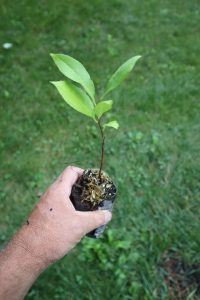
Black cherry starter tree (prunus serotina) Common eastern North American tree that can get 80ft plus. Prized for its wood, has clusters of white flowers in spring which turn to small clusters of dark colored little cherries. The bark is rather unique too. We like it because multiple butterfly and moths prefer it as a hostplant including the red spotted purple, eastern tiger swallowtail, promethea moth, and cecropia moth.
All of our plants are grown in biodegradable fabric pots. The containers are around 4″x4 1/2″ May be planted in the pot or removed . Generally, I like to take them off and compost them, but if you leave them on, I like to rip the sides or score them with a knife for easier root penetration.
Tips for growing:
As our plants are intended for pollinator gardens, they have not been treated with anything. Native plants don’t need any fertilizer, but if you want to lightly use an organic fertilizer, it won’t hurt.
The best place for our plants is in the ground. Do not grow in black plastic nursery pots “till they get bigger” Black plastic pots do not provide good aeration, get very hot, and will cause root circling and poor growth. Although being small, native plants often grow extensive root systems, often more than the visible foliage. When planted in the ground they will have the best chance to work on their roots.
When it comes to native perennials, roots are the most important part. While foliage can be an indicator of good growth, you want to give these plants the best chance for root growth. Don’t worry about flowering, it will come. Encourage roots!
We take care in packing our plants for shipping, but plants ocassionally get bent, broken stems in transit. This can appear disappointing, but they have good roots and will quickly recover.
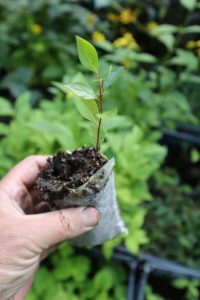
Black chokeberry (aronia melanocarpa) starter shrub. An adaptable shrub that gets to around 8ft. Grows in a variety of conditions. Berries are quite tart but can be used for cooking, jellies, jams. Pretty reddish fall color. I have found eastern tiger swallowtail caterpillars on them, but doesn’t appear to be one of their primary hosts.
These have gone dormant for the year, but still have excellent root growth and can be planted anytime the ground isn’t frozen. Just treat as is though it were still growing and water through any prolonged dry spells. These are grown outside here in Michigan. They may still have some foliage or yellowing foliage if ordered in early fall but as fall progresses and through winter, will just be old stems. Planting dormant plants is a great way to get plants established for next season!
All of our plants are grown in biodegradable fabric pots. The containers are around 4″x4 1/2″ May be planted in the pot or removed .
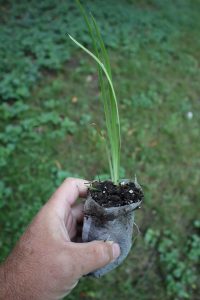
Blue flag iris starter plant (Iris virginica) Native iris usually found on lake, pond, and stream edges. Even though it is found in wetlands in the wild, it will also grow in medium soils that don’t dry out. Excellent rain garden plant. Blue/ purple flowers in midsummer with typical iris shape.
These are one year old plants that are up and growing for the 2024 season. The picture taken of the plant is a pot size indicator. They can be at various stages of growth through the season. If purchased early in the season they may be just coming up. In mid-season we may have cut them back for shipping purposes, Late in the season, they might showing signs of upcoming dormancy. Our plants have good roots which is the most important part for a successful native plant pollinator/ butterfly garden!
All of our plants are grown in biodegradable fabric pots. The containers are around 4″x4 1/2″ May be planted in the pot or removed . Generally, I like to take them off and compost them, but if you leave them on, I like to rip the sides or score them with a knife for easier root penetration.
Tips for growing:
As our plants are intended for pollinator gardens, they have not been treated with anything. Native plants don’t need any fertilizer, but if you want to lightly use an organic fertilizer, it won’t hurt.
The best place for our plants is in the ground. Do not grow in black plastic nursery pots “till they get bigger” Black plastic pots do not provide good aeration, get very hot, and will cause root circling and poor growth. Although being small, native plants often grow extensive root systems, often more than the visible foliage. When planted in the ground they will have the best chance to work on their roots.
When it comes to native perennials, roots are the most important part. While foliage can be an indicator of good growth, you want to give these plants the best chance for root growth. Don’t worry about flowering, it will come. Encourage roots!
We take care in packing our plants for shipping, but plants ocassionally get bent, broken stems in transit. This can appear disappointing, but they have good roots and will quickly recover.
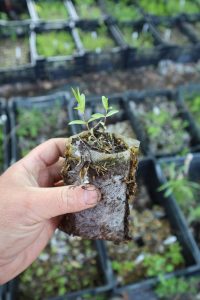
Bottle gentian starter plant (Gentiana andrewsii). A beautiful unique plant for medium to moist sunny to partly sunny locations gets around 2 to 2 1/2 ft tall. Slow growing, but easy once established. Unique blue flowers that bloom in late summer/ early fall.
These are one year old plants that are up and growing for the 2024 season. The picture taken of the plant is a pot size indicator. They can be at various stages of growth through the season. If purchased early in the season they may be just coming up. In mid-season we may have cut them back for shipping purposes, Late in the season, they might showing signs of upcoming dormancy. Our plants have good roots which is the most important part for a successful native plant pollinator/ butterfly garden!
All of our plants are grown in biodegradable fabric pots. The containers are around 4″x4 1/2″ May be planted in the pot or removed . Generally, I like to take them off and compost them, but if you leave them on, I like to rip the sides or score them with a knife for easier root penetration.
Tips for growing:
As our plants are intended for pollinator gardens, they have not been treated with anything. Native plants don’t need any fertilizer, but if you want to lightly use an organic fertilizer, it won’t hurt.
The best place for our plants is in the ground. Do not grow in black plastic nursery pots “till they get bigger” Black plastic pots do not provide good aeration, get very hot, and will cause root circling and poor growth. Although being small, native plants often grow extensive root systems, often more than the visible foliage. When planted in the ground they will have the best chance to work on their roots.
When it comes to native perennials, roots are the most important part. While foliage can be an indicator of good growth, you want to give these plants the best chance for root growth. Don’t worry about flowering, it will come. Encourage roots!
We take care in packing our plants for shipping, but plants ocassionally get bent, broken stems in transit. This can appear disappointing, but they have good roots and will quickly recover.
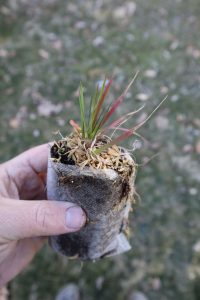
Bottlebrush grass (Elymus hystrix) starter plant. A grass for shade. Gets about 3 ft with unique heads hence it’s name. Likes a medium to medium/ dry shady to partially sunny location.
These are one year old plants that are up and growing for the 2024 season. The picture taken of the plant is a pot size indicator. They can be at various stages of growth through the season. If purchased early in the season they may be just coming up. In mid-season we may have cut them back for shipping purposes, Late in the season, they might showing signs of upcoming dormancy. Our plants have good roots which is the most important part for a successful native plant pollinator/ butterfly garden!
All of our plants are grown in biodegradable fabric pots. The containers are around 4″x4 1/2″ May be planted in the pot or removed . Generally, I like to take them off and compost them, but if you leave them on, I like to rip the sides or score them with a knife for easier root penetration.
Tips for growing:
As our plants are intended for pollinator gardens, they have not been treated with anything. Native plants don’t need any fertilizer, but if you want to lightly use an organic fertilizer, it won’t hurt.
The best place for our plants is in the ground. Do not grow in black plastic nursery pots “till they get bigger” Black plastic pots do not provide good aeration, get very hot, and will cause root circling and poor growth. Although being small, native plants often grow extensive root systems, often more than the visible foliage. When planted in the ground they will have the best chance to work on their roots.
When it comes to native perennials, roots are the most important part. While foliage can be an indicator of good growth, you want to give these plants the best chance for root growth. Don’t worry about flowering, it will come. Encourage roots!
We take care in packing our plants for shipping, but plants ocassionally get bent, broken stems in transit. This can appear disappointing, but they have good roots and will quickly recover.
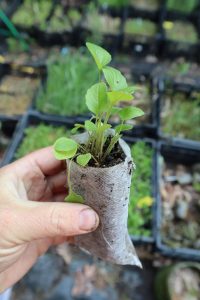
Brown eyed susan starter plant (Rudbeckia triloba) Prairie sun loving plant. Gets taller than a black eyed susan (5ft) with a more branched look with more flowers. A short lived perennial, but a good self seeder.
These are one year old plants that are up and growing for the 2024 season. The picture taken of the plant is a pot size indicator. They can be at various stages of growth through the season. If purchased early in the season they may be just coming up. In mid-season we may have cut them back for shipping purposes, Late in the season, they might showing signs of upcoming dormancy. Our plants have good roots which is the most important part for a successful native plant pollinator/ butterfly garden!
All of our plants are grown in biodegradable fabric pots. The containers are around 4″x4 1/2″ May be planted in the pot or removed . Generally, I like to take them off and compost them, but if you leave them on, I like to rip the sides or score them with a knife for easier root penetration.
Tips for growing:
As our plants are intended for pollinator gardens, they have not been treated with anything. Native plants don’t need any fertilizer, but if you want to lightly use an organic fertilizer, it won’t hurt.
The best place for our plants is in the ground. Do not grow in black plastic nursery pots “till they get bigger” Black plastic pots do not provide good aeration, get very hot, and will cause root circling and poor growth. Although being small, native plants often grow extensive root systems, often more than the visible foliage. When planted in the ground they will have the best chance to work on their roots.
When it comes to native perennials, roots are the most important part. While foliage can be an indicator of good growth, you want to give these plants the best chance for root growth. Don’t worry about flowering, it will come. Encourage roots!
We take care in packing our plants for shipping, but plants ocassionally get bent, broken stems in transit. This can appear disappointing, but they have good roots and will quickly recover.
Brown fox sedge (Carex vulpinoidea) starter plant. This is an easy sedge to grow and will happily accept most soil types in a sunny to partially shady area. Grows to about 3ft tall. Gets it’s name from it’s seed head that is said to look like a foxes tail.
Grows during the cooler parts of the year in the spring and fall
These are one year old plants that are up and growing for the 2024 season. The picture taken of the plant is a pot size indicator. They can be at various stages of growth through the season. If purchased early in the season they may be just coming up. In mid-season we may have cut them back for shipping purposes, Late in the season, they might showing signs of upcoming dormancy. Our plants have good roots which is the most important part for a successful native plant pollinator/ butterfly garden!
All of our plants are grown in biodegradable fabric pots. The containers are around 4″x4 1/2″ May be planted in the pot or removed . Generally, I like to take them off and compost them, but if you leave them on, I like to rip the sides or score them with a knife for easier root penetration.
Tips for growing:
As our plants are intended for pollinator gardens, they have not been treated with anything. Native plants don’t need any fertilizer, but if you want to lightly use an organic fertilizer, it won’t hurt.
The best place for our plants is in the ground. Do not grow in black plastic nursery pots “till they get bigger” Black plastic pots do not provide good aeration, get very hot, and will cause root circling and poor growth. Although being small, native plants often grow extensive root systems, often more than the visible foliage. When planted in the ground they will have the best chance to work on their roots.
When it comes to native perennials, roots are the most important part. While foliage can be an indicator of good growth, you want to give these plants the best chance for root growth. Don’t worry about flowering, it will come. Encourage roots!
We take care in packing our plants for shipping, but plants ocassionally get bent, broken stems in transit. This can appear disappointing, but they have good roots and will quickly recover.
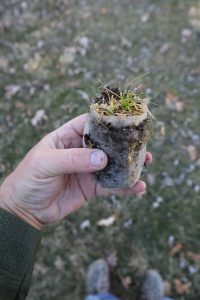
Bush’s coneflower (Echinacea paradoxa) starter plant. A yellow echinacea. Native to the Ozark region but grows well throughout much of the US. Has a sweet scent to the flowers and is popular with butterflies. I get more butterflies visiting these than other echinacea. Much like pale purple coneflower it is slower growing and takes longer to get established than purple coneflower but worth the wait.
These are one year old plants that are up and growing for the 2024 season. The picture taken of the plant is a pot size indicator. They can be at various stages of growth through the season. If purchased early in the season they may be just coming up. In mid-season we may have cut them back for shipping purposes, Late in the season, they might showing signs of upcoming dormancy. Our plants have good roots which is the most important part for a successful native plant pollinator/ butterfly garden!
All of our plants are grown in biodegradable fabric pots. The containers are around 4″x4 1/2″ May be planted in the pot or removed . Generally, I like to take them off and compost them, but if you leave them on, I like to rip the sides or score them with a knife for easier root penetration.
Tips for growing:
As our plants are intended for pollinator gardens, they have not been treated with anything. Native plants don’t need any fertilizer, but if you want to lightly use an organic fertilizer, it won’t hurt.
The best place for our plants is in the ground. Do not grow in black plastic nursery pots “till they get bigger” Black plastic pots do not provide good aeration, get very hot, and will cause root circling and poor growth. Although being small, native plants often grow extensive root systems, often more than the visible foliage. When planted in the ground they will have the best chance to work on their roots.
When it comes to native perennials, roots are the most important part. While foliage can be an indicator of good growth, you want to give these plants the best chance for root growth. Don’t worry about flowering, it will come. Encourage roots!
We take care in packing our plants for shipping, but plants ocassionally get bent, broken stems in transit. This can appear disappointing, but they have good roots and will quickly recover.
